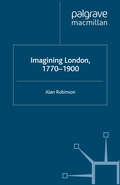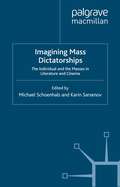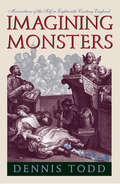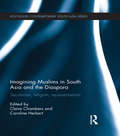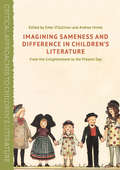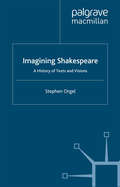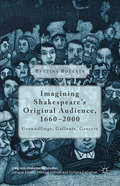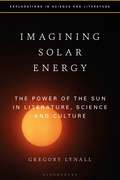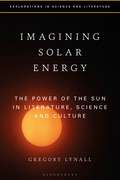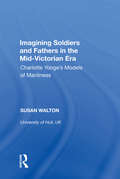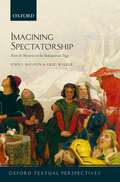- Table View
- List View
Imagining Jewish Art: Encounters with the Masters in Chagall, Guston, and Kitaj
by Aaron RosenShort-listed for the Art and Christian Enquiry/Mercers' International Book Award 2009: 'a book which makes an outstanding contribution to the dialogue between religious faith and the visual arts'. What does modern Jewish art look like? Where many scholars, critics, and curators have gone searching for the essence of Jewish art in Biblical illustrations and other traditional subjects, Rosen sets out to discover Jewishness in unlikely places. How, he asks, have modern Jewish painters explored their Jewish identity using an artistic past which is- by and large - non-Jewish? In this new book we encounter some of the great works of Western art history through Jewish eyes. We see Matthias Grunewald's Isenheim Altarpiece re-imagined by Marc Chagall (1887-1985), traces of Paolo Uccello and Piero della Francesca in Philip Guston (1913-1980), and images by Diego Velazquez and Paul Cezanne studiously reworked by R.B. Kitaj (1932-2007). This highly comparative study draws on theological, philosophical and literary sources from Franz Rosenzweig to Franz Kafka and Philip Roth. Rosen deepens our understanding not only of Chagall, Guston, and Kitaj but also of how art might serve as a key resource for rethinking such fundamental Jewish concepts as family, tradition, and homeland.
Imagining Language in America: From the Revolution to the Civil War
by Michael P. KramerIn this study of the rhetoric of American writings on language, Michael Kramer argues that the prevalent critical distinction between imaginative and nonimaginative writing is of limited theoretical use. Breaking down the artificial, disciplinary barriers between two areas of scholarly inquiry--the literature of the American Renaissance and the study of language in the United States between the Revolution and the Civil War--Kramer finds in various walks of intellectual life a broad range of writers who "imagined language" for the new experiment in self-government. Each of these men combined ideas about language with ideas about America so as to form cultural fictions, or creative renderings of the nation--its meaning, its character, and how it worked. In order to reassess American linguistic and literary nationalism, Kramer allows Noah Webster, whose influential grammatical and lexicographic works have been considered only marginal to literary history, to share the stage with more conventionally literary figures--the neglected Longfellow and the canonical Whitman. Then an essay on The Federalist and the pragmatic language-related problems faced by the founding fathers introduces revisionary analyses of two New England writers who confronted American culture and society through their Romantic critiques of language: the minister and theologian Horace Bushnell and Nathaniel Hawthorne.Originally published in 1991.The Princeton Legacy Library uses the latest print-on-demand technology to again make available previously out-of-print books from the distinguished backlist of Princeton University Press. These editions preserve the original texts of these important books while presenting them in durable paperback and hardcover editions. The goal of the Princeton Legacy Library is to vastly increase access to the rich scholarly heritage found in the thousands of books published by Princeton University Press since its founding in 1905.
Imagining London, 1770-1900
by A. RobinsonCombining a unique overview of metropolitan visual culture with detailed textual analysis, this interdisciplinary study explores the relationship between the two cities which Londoners inhabited: the physical spaces of the metropolis, whose socially stratified and gendered topography was shaped by consumer culture and unregulated capitalism; and an imaginary 'London', an 'Unreal City' which reflected and influenced their understanding of, and actions in, the 'real' environment.
Imagining Mass Dictatorships: The Individual and the Masses in Literature and Cinema (Mass Dictatorship in the Twentieth Century)
by Michael Schoenhals and Karin SarsenovThis volume in the series Mass Dictatorship in the Twentieth Century series sees twelve Swedish, Korean and Japanese scholars, theorists, and historians of fiction and non-fiction probe the literary subject of life in 20th century mass dictatorships.
Imagining Methodism in Eighteenth-Century Britain: Enthusiasm, Belief, and the Borders of the Self
by Misty G. AndersonIn the eighteenth century, British Methodism was an object of both derision and desire. Many popular eighteenth-century works ridiculed Methodists, yet often the very same plays, novels, and prints that cast Methodists as primitive, irrational, or deluded also betrayed a thinly cloaked fascination with the experiences of divine presence attributed to the new evangelical movement. Misty G. Anderson argues that writers, actors, and artists used Methodism as a concept to interrogate the boundaries of the self and the fluid relationships between religion and literature, between reason and enthusiasm, and between theater and belief. Imagining Methodism situates works by Henry Fielding, John Cleland, Samuel Foote, William Hogarth, Horace Walpole, Tobias Smollett, and others alongside the contributions of John Wesley, Charles Wesley, and George Whitefield in order to understand how Methodism's brand of "experimental religion" was both born of the modern world and perceived as a threat to it.Anderson's analysis of reactions to Methodism exposes a complicated interlocking picture of the religious and the secular, terms less transparent than they seem in current critical usage. Her argument is not about the lives of eighteenth-century Methodists; rather, it is about Methodism as it was imagined in the work of eighteenth-century British writers and artists, where it served as a sign of sexual, cognitive, and social danger. By situating satiric images of Methodists in their popular contexts, she recaptures a vigorous cultural debate over the domains of religion and literature in the modern British imagination. Rich in cultural and literary analysis, Anderson's argument will be of interest to students and scholars of the eighteenth century, religious studies, theater, and the history of gender.
Imagining Methodism in Eighteenth-Century Britain: Enthusiasm, Belief, and the Borders of the Self
by Misty G. AndersonIn the eighteenth century, British Methodism was an object of both derision and desire. Many popular eighteenth-century works ridiculed Methodists, yet often the very same plays, novels, and prints that cast Methodists as primitive, irrational, or deluded also betrayed a thinly cloaked fascination with the experiences of divine presence attributed to the new evangelical movement. Misty G. Anderson argues that writers, actors, and artists used Methodism as a concept to interrogate the boundaries of the self and the fluid relationships between religion and literature, between reason and enthusiasm, and between theater and belief. Imagining Methodism situates works by Henry Fielding, John Cleland, Samuel Foote, William Hogarth, Horace Walpole, Tobias Smollett, and others alongside the contributions of John Wesley, Charles Wesley, and George Whitefield in order to understand how Methodism's brand of "experimental religion" was both born of the modern world and perceived as a threat to it.Anderson's analysis of reactions to Methodism exposes a complicated interlocking picture of the religious and the secular, terms less transparent than they seem in current critical usage. Her argument is not about the lives of eighteenth-century Methodists; rather, it is about Methodism as it was imagined in the work of eighteenth-century British writers and artists, where it served as a sign of sexual, cognitive, and social danger. By situating satiric images of Methodists in their popular contexts, she recaptures a vigorous cultural debate over the domains of religion and literature in the modern British imagination. Rich in cultural and literary analysis, Anderson's argument will be of interest to students and scholars of the eighteenth century, religious studies, theater, and the history of gender.
Imagining Monsters: Miscreations of the Self in Eighteenth-Century England
by Dennis ToddIn 1726, an illiterate woman from Surrey named Mary Toft announced that she had given birth to seventeen rabbits. Deceiving respected physicians and citizens alike, she created a hoax that held England spellbound for months. In Imagining Monsters, Dennis Todd tells the story of this bizarre incident and shows how it illuminates eighteenth-century beliefs about the power of imagination and the problems of personal identity. Mary Toft's outrageous claim was accepted because of a common belief that the imagination of a pregnant woman could deform her fetus, creating a monster within her. Drawing on largely unexamined material from medicine, embryology, philosophy, and popular "monster" exhibitions, Todd shows that such ideas about monstrous births expressed a fear central to scientific, literary, and philosophical thinking: that the imagination could transgress the barrier between mind and body. In his analysis of the Toft case, Todd exposes deep anxieties about the threat this transgressive imagination posed to the idea of the self as stable, coherent, and autonomous. Major works of Pope and Swift reveal that they, too, were concerned with these issues, and Imagining Monsters provides detailed discussions of Gulliver's Travels and The Dunciad illustrating how these writers used images of monstrosity to explore the problematic nature of human identity. It also includes a provocative analysis of Pope's later work that takes into account his physical deformity and his need to defend himself in a society that linked a deformed body with a deformed character.
Imagining Motherhood in Contemporary Irish and Caribbean Literature (New Caribbean Studies)
by Abigail L. PalkoImagining Motherhood in Contemporary Irish and Caribbean Literature undertakes a comparative transnational reading to develop more expansive literary models of good mothering. Abigail L. Palko argues that Irish and Caribbean literary representations of non-normative mothering practices do not reflect transgressive or dangerous mothering but are rather cultural negotiations of the definition of a good mother. This original book demonstrates the sustained commitment to countering the dominant ideologies of maternal self-sacrifice foundational to both Irish and Caribbean nationalist rhetoric, offering instead the possibility of integrating maternal agency into an effective model of female citizenship.
Imagining Muslims in South Asia and the Diaspora: Secularism, Religion, Representations (Routledge Contemporary South Asia Series)
by Claire Chambers Caroline HerbertLiterary, cinematic and media representations of the disputed category of the ‘South Asian Muslim’ have undergone substantial change in the last few decades and particularly since the events of September 11, 2001. Here we find the first book-length critical analysis of these representations of Muslims from South Asia and its diaspora in literature, the media, culture and cinema. Contributors contextualize these depictions against the burgeoning post-9/11 artistic interest in Islam, and also against cultural responses to earlier crises on the subcontinent such as Partition (1947), the 1971 Indo-Pakistan war and secession of Bangladesh, the 1992 Ayodhya riots , the 2002 Gujarat genocide and the Kashmir conflict. Offering a comparative approach, the book explores connections between artists’ generic experimentalism and their interpretations of life as Muslims in South Asia and its diaspora, exploring literary and popular fiction, memoir, poetry, news media, and film. The collection highlights the diversity of representations of Muslims and the range of approaches to questions of Muslim religious and cultural identity, as well as secular discourse. Essays by leading scholars in the field highlight the significant role that literature, film, and other cultural products such as music can play in opening up space for complex reflections on Muslim identities and cultures, and how such imaginative cultural forms can enable us to rethink secularism and religion. Surveying a broad range of up-to-date writing and cultural production, this concise and pioneering critical analysis of representations of South Asian Muslims will be of interest to students and academics of a variety of subjects including Asian Studies, Literary Studies, Media Studies, Women’s Studies, Contemporary Politics, Migration History, Film studies, and Cultural Studies.
Imagining Muslims in South Asia and the Diaspora: Secularism, Religion, Representations (Routledge Contemporary South Asia Series)
by Claire Chambers Caroline HerbertLiterary, cinematic and media representations of the disputed category of the ‘South Asian Muslim’ have undergone substantial change in the last few decades and particularly since the events of September 11, 2001. Here we find the first book-length critical analysis of these representations of Muslims from South Asia and its diaspora in literature, the media, culture and cinema. Contributors contextualize these depictions against the burgeoning post-9/11 artistic interest in Islam, and also against cultural responses to earlier crises on the subcontinent such as Partition (1947), the 1971 Indo-Pakistan war and secession of Bangladesh, the 1992 Ayodhya riots , the 2002 Gujarat genocide and the Kashmir conflict. Offering a comparative approach, the book explores connections between artists’ generic experimentalism and their interpretations of life as Muslims in South Asia and its diaspora, exploring literary and popular fiction, memoir, poetry, news media, and film. The collection highlights the diversity of representations of Muslims and the range of approaches to questions of Muslim religious and cultural identity, as well as secular discourse. Essays by leading scholars in the field highlight the significant role that literature, film, and other cultural products such as music can play in opening up space for complex reflections on Muslim identities and cultures, and how such imaginative cultural forms can enable us to rethink secularism and religion. Surveying a broad range of up-to-date writing and cultural production, this concise and pioneering critical analysis of representations of South Asian Muslims will be of interest to students and academics of a variety of subjects including Asian Studies, Literary Studies, Media Studies, Women’s Studies, Contemporary Politics, Migration History, Film studies, and Cultural Studies.
Imagining Otherwise: How Readers Help to Write Nineteenth-Century Novels
by Debra GettelmanHow Victorian authors engaged the imaginations of their readers and elevated the novel to new heightsAs novel publication exploded in nineteenth-century Britain, writers such as Jane Austen, Charles Dickens, and George Eliot learned from experience—sometimes grudgingly—that readers tend to make their own imaginative contributions to fictional worlds. Imagining Otherwise shows how Victorian writers acknowledged, grappled with, and ultimately enlisted the prerogative of readers to conjure alternatives and add depth to the words on the page.Debra Gettelman provides incisive new readings of novels such as Sense and Sensibility, Little Dorrit, and Middlemarch, exploring how novelists known for prescriptive and didactic narrative voices were at the same time exploring the aesthetic potential for the reader&’s independent imagination to lend nuance and authenticity to fiction. Modernist authors of the twentieth century have long been considered pioneers in cultivating the reader&’s capacity to imagine what is not said as part of the art of fiction. Gettelman uncovers the roots of this tradition of novel reading a century earlier and challenges literary criticism that dismisses this spontaneous, readerly impulse as being unworthy of serious examination.As readers demand novels with relatable characters and fan fiction grows in popularity, the reader&’s imagination has become a determining element of today&’s literary environment. Imagining Otherwise takes a deeper look at this history, offering a critical perspective on how we came to view fiction as a site of imaginative appropriation.
Imagining Outer Space: European Astroculture in the Twentieth Century (Palgrave Studies in the History of Science and Technology)
by Alexander C.T. GeppertImagining Outer Space makes a captivating advance into the cultural history of outer space and extraterrestrial life in the European imagination. How was outer space conceived and communicated? What promises of interplanetary expansion and cosmic colonization propelled the project of human spaceflight to the forefront of twentieth-century modernity? In what way has West-European astroculture been affected by the continuous exploration of outer space? Tracing the thriving interest in spatiality to early attempts at exploring imaginary worlds beyond our own, the book analyzes contact points between science and fiction from a transdisciplinary perspective and examines sites and situations where utopian images and futuristic technologies contributed to the omnipresence of fantasmatic thought. Bringing together state-of-the-art work in this emerging field of historical research, the volume breaks new ground in the historicization of the Space Age.
Imagining Sameness and Difference in Children's Literature: From the Enlightenment to the Present Day (Critical Approaches to Children's Literature)
by Andrea Immel Emer O'SullivanThis book investigates how cultural sameness and difference has been presented in a variety of forms and genres of children’s literature from Denmark, Germany, France, Russia, Britain, and the United States; ranging from English caricatures of the 1780s to dynamic representations of contemporary cosmopolitan childhood. The chapters address different models of presenting foreigners using examples from children’s educational prints, dramatic performances, travel narratives, comics, and picture books. Contributors illuminate the ways in which the texts negotiate the tensions between the Enlightenment ideal of internationalism and discrete national or ethnic identities cultivated since the Romantic era, providing examples of ethnocentric cultural perspectives and of cultural relativism, as well as instances where discussions of child reader agency indicate how they might participate eventually in a tolerant transnational community.
Imagining Shakespeare: A History of Texts and Visions
by Stephen OrgelIn this beautifully illustrated book, one of the foremost Shakespeareans of our time explores the ways in which Shakespeare has been imagined from his time to ours. Drawing on performance history, textual history and the visual arts (including a fascinating chapter on portraiture), Imagining Shakespeare displays throughout the cultural versatility, elegance, lucidity and wit which have become the hallmarks of Stephen Orgel's style.
Imagining Shakespeare's Original Audience, 1660-2000: Groundlings, Gallants, Grocers (Palgrave Shakespeare Studies)
by Bettina BoeckerComparatively little is known about Shakespeare's first audiences. This study argues that the Elizabethan audience is an essential part of Shakespeare as a site of cultural meaning, and that the way criticism thinks of early modern theatregoers is directly related to the way it thinks of, and uses, the Bard himself.
Imagining Socialism: Aesthetics, Anti-politics, and Literature in Britain, 1817-1918
by Mark A. Allison"Socialism" names a form of collective life that has never been fully realized; consequently, it is best understood as a goal to be imagined. So this study argues, and thereby uncovers an aesthetic impulse that animates some of the most consequential socialist writing, thought, and practice of the long nineteenth century. Imagining Socialism explores this tradition of radical activism, investigating the diverse ways that British socialists—from Robert Owen to the mid-century Christian Socialists to William Morris—marshalled the resources of the aesthetic in their efforts to surmount "politics" and develop non-governmental forms of collective life. Their ambitious attempts at social regeneration led some socialists to explore the liberatory possibilities afforded by cooperative labor, women's emancipation, political violence, and the power of the arts themselves. Imagining Socialism demonstrates that, far from being confined to the "socialist revival" of the fin de siècle, important socialist experiments with the emancipatory potential of the aesthetic in Britain may be found throughout the period it calls the "socialist century"—and may still inspire us today.
Imagining Socialism: Aesthetics, Anti-politics, and Literature in Britain, 1817-1918
by Mark A. Allison"Socialism" names a form of collective life that has never been fully realized; consequently, it is best understood as a goal to be imagined. So this study argues, and thereby uncovers an aesthetic impulse that animates some of the most consequential socialist writing, thought, and practice of the long nineteenth century. Imagining Socialism explores this tradition of radical activism, investigating the diverse ways that British socialists—from Robert Owen to the mid-century Christian Socialists to William Morris—marshalled the resources of the aesthetic in their efforts to surmount "politics" and develop non-governmental forms of collective life. Their ambitious attempts at social regeneration led some socialists to explore the liberatory possibilities afforded by cooperative labor, women's emancipation, political violence, and the power of the arts themselves. Imagining Socialism demonstrates that, far from being confined to the "socialist revival" of the fin de siècle, important socialist experiments with the emancipatory potential of the aesthetic in Britain may be found throughout the period it calls the "socialist century"—and may still inspire us today.
Imagining Solar Energy: The Power of the Sun in Literature, Science and Culture (Explorations in Science and Literature)
by Gregory LynallHow has humanity sought to harness the power of the Sun, and what roles have literature, art and other cultural forms played in imagining, mythologizing and reflecting the possibilities of solar energy? What stories have been told about solar technologies, and how have these narratives shaped developments in science and culture? What can solar power's history tell us about its future, within a world adapting to climate crisis? Identifying the history of capturing solar radiance as a focal point between science and the imagination, Imagining Solar Energy argues that the literary, artistic and mythical resonances of solar power – from the Renaissance to the present day – have not only been inspired by, but have also cultivated and sustained its scientific and technological development. Ranging from Archimedes to Isaac Asimov, John Dee to Humphry Davy, Aphra Behn to J. G. Ballard, the book argues that solar energy translates into many different kinds of power (physical, political, intellectual and cultural), and establishes for the first time the importance of solar energy to many literary and scientific endeavours.
Imagining Solar Energy: The Power of the Sun in Literature, Science and Culture (Explorations in Science and Literature)
by Gregory LynallHow has humanity sought to harness the power of the Sun, and what roles have literature, art and other cultural forms played in imagining, mythologizing and reflecting the possibilities of solar energy? What stories have been told about solar technologies, and how have these narratives shaped developments in science and culture? What can solar power's history tell us about its future, within a world adapting to climate crisis? Identifying the history of capturing solar radiance as a focal point between science and the imagination, Imagining Solar Energy argues that the literary, artistic and mythical resonances of solar power – from the Renaissance to the present day – have not only been inspired by, but have also cultivated and sustained its scientific and technological development. Ranging from Archimedes to Isaac Asimov, John Dee to Humphry Davy, Aphra Behn to J. G. Ballard, the book argues that solar energy translates into many different kinds of power (physical, political, intellectual and cultural), and establishes for the first time the importance of solar energy to many literary and scientific endeavours.
Imagining Soldiers and Fathers in the Mid-Victorian Era: Charlotte Yonge's Models of Manliness
by Susan WaltonBeginning with the premise that women's perceptions of manliness are crucial to its construction, The author focuses on the life and writings of Charlotte Yonge as a prism for understanding the formulation of masculinities in the Victorian period. Yonge was a prolific writer whose bestselling fiction and extensive journalism enjoyed a wide readership. The author situates Yonge's work in the context of her family connections with the army, showing that an interlocking of worldly and spiritual warfare was fundamental to Yonge's outlook. For Yonge, all good Christians are soldiers, and Walton argues persuasively that the medievalised discourse of sanctified violence executed by upright moral men that is often connected with late nineteenth-century Imperialism began earlier in the century, and that Yonge's work was one major strand that gave it substance. Of significance, Yonge also endorsed missionary work, which she viewed as an extension of a father's duties in the neighborhood and which was closely allied to a vigorous promotion of refashioned Tory paternalism. The author's study is rich in historical context, including Yonge's connections with the Tractarians, the effects of industrialization, and Britain's Imperial enterprises. Informed by extensive archival scholarship, Walton offers important insights into the contradictory messages about manhood current in the mid-nineteenth century through the works of a major but undervalued Victorian author.
Imagining Soldiers and Fathers in the Mid-Victorian Era: Charlotte Yonge's Models of Manliness
by Susan WaltonBeginning with the premise that women's perceptions of manliness are crucial to its construction, The author focuses on the life and writings of Charlotte Yonge as a prism for understanding the formulation of masculinities in the Victorian period. Yonge was a prolific writer whose bestselling fiction and extensive journalism enjoyed a wide readership. The author situates Yonge's work in the context of her family connections with the army, showing that an interlocking of worldly and spiritual warfare was fundamental to Yonge's outlook. For Yonge, all good Christians are soldiers, and Walton argues persuasively that the medievalised discourse of sanctified violence executed by upright moral men that is often connected with late nineteenth-century Imperialism began earlier in the century, and that Yonge's work was one major strand that gave it substance. Of significance, Yonge also endorsed missionary work, which she viewed as an extension of a father's duties in the neighborhood and which was closely allied to a vigorous promotion of refashioned Tory paternalism. The author's study is rich in historical context, including Yonge's connections with the Tractarians, the effects of industrialization, and Britain's Imperial enterprises. Informed by extensive archival scholarship, Walton offers important insights into the contradictory messages about manhood current in the mid-nineteenth century through the works of a major but undervalued Victorian author.
Imagining Spectatorship: From the Mysteries to the Shakespearean Stage (Oxford Textual Perspectives)
by John J. McGavin Greg WalkerOxford Textual Perspectives is a new series of informative and provocative studies focused upon literary texts (conceived of in the broadest sense of that term) and the technologies, cultures and communities that produce, inform, and receive them. It provides fresh interpretations of fundamental works and of the vital and challenging issues emerging in English literary studies. By engaging with the materiality of the literary text, its production, and reception history, and frequently testing and exploring the boundaries of the notion of text itself, the volumes in the series question familiar frameworks and provide innovative interpretations of both canonical and less well-known works. Imagining Spectatorship offers a new discussion of how spectators witnessed early drama in the various spaces and places in which those works were performed. It combines broad historical and theoretical reflection with closely analysed case studies to produce a comprehensive account of the ways in which individuals encountered early drama, how they were cued to respond to it, and how we might think about those issues today. It addresses the practical matters that conditioned spectatorship, principally those concerned with the location and configuration of the spaces in which a performance occurred, but also suggests how these factors intersected with social status, gender, religious commitment and affiliation, degrees of real or felt personal agency, and the operation of the cognitive processes themselves. It considers both real witnesses and those 'imagined' spectators which are seemingly figured by both dramatic and quasi-dramatic works, and whose assumed attitudes play-makers sought to second-guess. It also looks at the spectatorial experience itself as a subject of representation in a number of early texts. Finally, it examines the complex contract entered into by audiences and players for the duration of a performance, looking at how texts cued spectators to respond to specific dramaturgical tropes and gambits and how audience response was itself a cause of potential anxiety for writers. The book resists the conventional divide between 'medieval' and 'early-modern' drama, using its focus on the spectators' experience to point connections and continuities across a diverse range of genres, such as processions and tourneys as well as scripted plays, pageants, and interludes; a variety of different venues, such as city streets, great halls, and playhouses, and a period of about 150 years to the Shakespearean stage of the 1590s and 1600s. It seeks to offer routes by which inferences about early spectatorship can be made despite the relative absence of personal testimony from the period.
Imagining Surveillance: Utopian and Dystopian Literature and Film
by Peter MarksCritically assesses how literary and cinematic eutopias and dystopias have imagined and evaluated surveillance. Imagining Surveillance presents the first full-length study of the depiction and assessment of surveillance in literature and film. Focusing on the utopian genre (which includes positive and negative worlds), this book offers an in-depth account of the ways in which the most creative writers, filmmakers and thinkers have envisioned alternative worlds in which surveillance in various forms plays a key concern. Ranging from Thomas More’s genre-defining Utopia to Spike Jones’ provocative film Her, Imagining Surveillance explores the long history of surveillance in creative texts well before and after George Orwell’s iconic Nineteen Eighty-Four. It fits that key novel into a five hundred year narrative that includes some of the most provocative and inventive accounts of surveillance as it is and as it might be in the future. The book explains the sustained use of these works by surveillance scholars, but goes much further and deeper in explicating their brilliant and challenging diversity. With chapters on surveillance studies, surveillance in utopias before Orwell, Nineteen Eighty-Four itself, and utopian texts post-Orwell that deal with visibility, spaces, identity, technology and the shape of things to come, Imagining Surveillance sits firmly in the emerging cultural studies of surveillance. Key Features: The first sustained account of the representation of surveillance in eutopian and dystopian literature and film Charts surveillance’s historical development and creative responses to that development Provides a detailed critical account of the ways that surveillance studies has utilised utopias to formulate its ideas Offers new readings of literary texts and films from More’s Utopia through George Orwell’s Nineteen Eighty-Four to Margaret Atwood’s Oryx and Crake and films from Fritz Lang’s Metropolis to Neil Blomkamp’s Elysium and beyond
Imagining Surveillance: Utopian and Dystopian Literature and Film
by Peter MarksCritically assesses how literary and cinematic eutopias and dystopias have imagined and evaluated surveillance. Imagining Surveillance presents the first full-length study of the depiction and assessment of surveillance in literature and film. Focusing on the utopian genre (which includes positive and negative worlds), this book offers an in-depth account of the ways in which the most creative writers, filmmakers and thinkers have envisioned alternative worlds in which surveillance in various forms plays a key concern. Ranging from Thomas More’s genre-defining Utopia to Spike Jones’ provocative film Her, Imagining Surveillance explores the long history of surveillance in creative texts well before and after George Orwell’s iconic Nineteen Eighty-Four. It fits that key novel into a five hundred year narrative that includes some of the most provocative and inventive accounts of surveillance as it is and as it might be in the future. The book explains the sustained use of these works by surveillance scholars, but goes much further and deeper in explicating their brilliant and challenging diversity. With chapters on surveillance studies, surveillance in utopias before Orwell, Nineteen Eighty-Four itself, and utopian texts post-Orwell that deal with visibility, spaces, identity, technology and the shape of things to come, Imagining Surveillance sits firmly in the emerging cultural studies of surveillance. Key Features: The first sustained account of the representation of surveillance in eutopian and dystopian literature and film Charts surveillance’s historical development and creative responses to that development Provides a detailed critical account of the ways that surveillance studies has utilised utopias to formulate its ideas Offers new readings of literary texts and films from More’s Utopia through George Orwell’s Nineteen Eighty-Four to Margaret Atwood’s Oryx and Crake and films from Fritz Lang’s Metropolis to Neil Blomkamp’s Elysium and beyond
Imagining Terrorism: The Rhetoric and Representation of Political Violence in Italy 1969-2009
by Pierpaolo AntonelloNo other European country experienced the disruption of political and everyday life suffered by Italy in the so-called 'years of lead' (1969-c.1983), when there were more than 12,000 incidents of terrorist violence. This experience affected all aspects of Italian cultural life, shaping political, judicial and everyday language as well as artistic representation of every kind. In this innovative and broad-ranging study, experts from the fields of philosophy, history, media, law, cinema, theatre and literary studies trace how the experience and legacies of terrorism have determined the form and content of Italian cultural production and shaped the country's way of thinking about such events?


